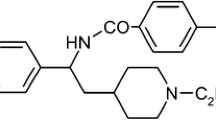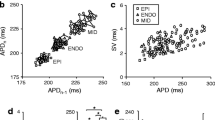Summary
The effects of the combined use of class-I antiarrhythmic drugs on the resting potentials (RP), amplitude of action potential (AMP), and V max of the action potential were investigated in guinea-pig ventricular papillary muscles that were superfused with oxygenated Krebs-Ringer solution at 35°C. Disopyramide (40 μM) reduced V max to 68.6 ± 3.1% (mean ± SE, n=5) of the control with minimal changes in RP and AMP when preparations were stimulated at 1 Hz. The addition of mexiletine (20 μM) to the solution containing disopyramide (40 μM) caused a minimal reduction of V max (less than 5%) for the stimulation of 1 Hz, but a significant reduction of V max (13% p<0.05) when stimulation was increased to 2 Hz. This amount of the reduction is compatible with that obtained by mexiletine alone, suggesting a simple additive Na+ channel inhibition by this drug combination. This additive effect was also observed in the recovery process of V max from the use-dependent block induced by train stimuli at 1 Hz. Flecainide (5 μM) reduced V max to 58.6±13.3% (n=5). The addition of mexiletine to the superfusate with flecainide produced a further depression of 14±2.6% of V max , even at 1 Hz. This depression was larger than that produced by mexiletine, suggesting a synergistic action of the two drugs on the Na+ channel. Such information about the interaction of the class I drug combinations with the Na+ channel may be clinically important.
Similar content being viewed by others
References
Levy, S. Combination therapy for cardiac arrhythmias. Am J Cardiol 1988;61:95A-101A.
Greenspan, AM, Spielman, SR, Horowitz, LN. Combination antiarrhythmic drug therapy for ventricular tachyarrhythmias. PACE 1986;9:565–576.
Duff, HJ, Mitchell, LB, Manyari, D, et al. Mexiletinequinidine combination: Electrophysiologic correlation of a favorable antiarrhythmic interaction in humans. J Am Coll Cardiol 1987;10:1149–1156.
Duff, HJ, Kolodgic, FD, Roden, DM, et al. Electropharmacologic synergism with mexiletine and quinidine. J Cardiovasc Pharmacol 1986;8:840–846.
Greenspan, AM, Spielman, SR, Webb, CR, et al. Efficacy of combination therapy with mexiletine and a type IA agent for inducible ventricular tachyarrhythmias secondary to coronary artery disease. Am J Cardiol 1985;56:277–284.
Breithhardt, G, Seipel, L, Abendroth, RR. Comparison of the antiarrhythmic efficacy of disopyramide and mexiletine against stimulus-induced ventricular tachycardia. J Cardiovasc Pharmacol 1981;3:1026–1037.
Hille, B. Local anesthetics: Hydrophilic and hydrophobic pathways for the drug-receptor reactions. J Gen Physiol 1977;69:497–515.
Hondeghem, LM, Katzung, BG. Time- and voltagedependent interaction of antiarrhythmic drugs with cardiac sodium channels. Biochim Biophys Acta 1977;472:373–398.
Bean, BP, Cohen, CJ, Tsien, RW. Block of cardiac sodium channels by tetrodotoxin and lidocaine: Sodium current and (V max ) experiments. In: APaes de Carvalho, ed. Normal and abnormal conduction in the heart. Mount Kisko, NY: Futura, 1982:189–209.
Toyama, J, Kodama, I, Kusunoki, T, et al. Use-dependent blicking action of newly developed lidocaine-analogs on maximum rate of rise of action potentials in guinea pig papillary muscle. Jpn Heart J 1987;28:273–285.
Campbell, TJ. Resting and rate-dependent depression of maximum rate of depolarization (V max ) in guinea pig ventricular action potentials by mexiletine, disopyramide, and encainide. J Cardiovasc Pharmacol 1983;5:291–296.
Campbell, TJ. Kinetics of onset of rate-dependent effects of class I antiarrhythmic drugs are important in determining their effects on refractoriness in guinea-pig ventricle, and provide a theoretical basis for their subclassification. Cardiovasc Res 1983;17:344–352.
Hondeghem, LM, Matsubara, T. Quinidine blocks cardiac sodium channels during opening and slow inactivation in guinea pig papillary muscle. Br J Pharmacol 1988;93: 311–318.
Kodama, I. Toyama, J, Takanaka, C, et al. Block of activated and inactivated sodium channels by class-I antiarrhythmic drugs studied by using the maximum upstroke velocity (Vmax) of action potential in guinea-pig cardiac muscles. J Mol Cell Cardiol 1987;19:367–377.
Sheets, MF, Hanck, DA, Fozzard, HA. Nonlinear relation between Vmax and INa in canine cardiac Purkinje cells. Circ Res 1988;63:386–398.
Author information
Authors and Affiliations
Rights and permissions
About this article
Cite this article
Toyama, J., Kawamura, T. & Kodama, I. Effects of combined use of class I antiarrhythmic agents on V max of guinea-pig ventricular muscles . Cardiovasc Drug Ther 5 (Suppl 4), 801–804 (1991). https://doi.org/10.1007/BF00120828
Issue Date:
DOI: https://doi.org/10.1007/BF00120828




